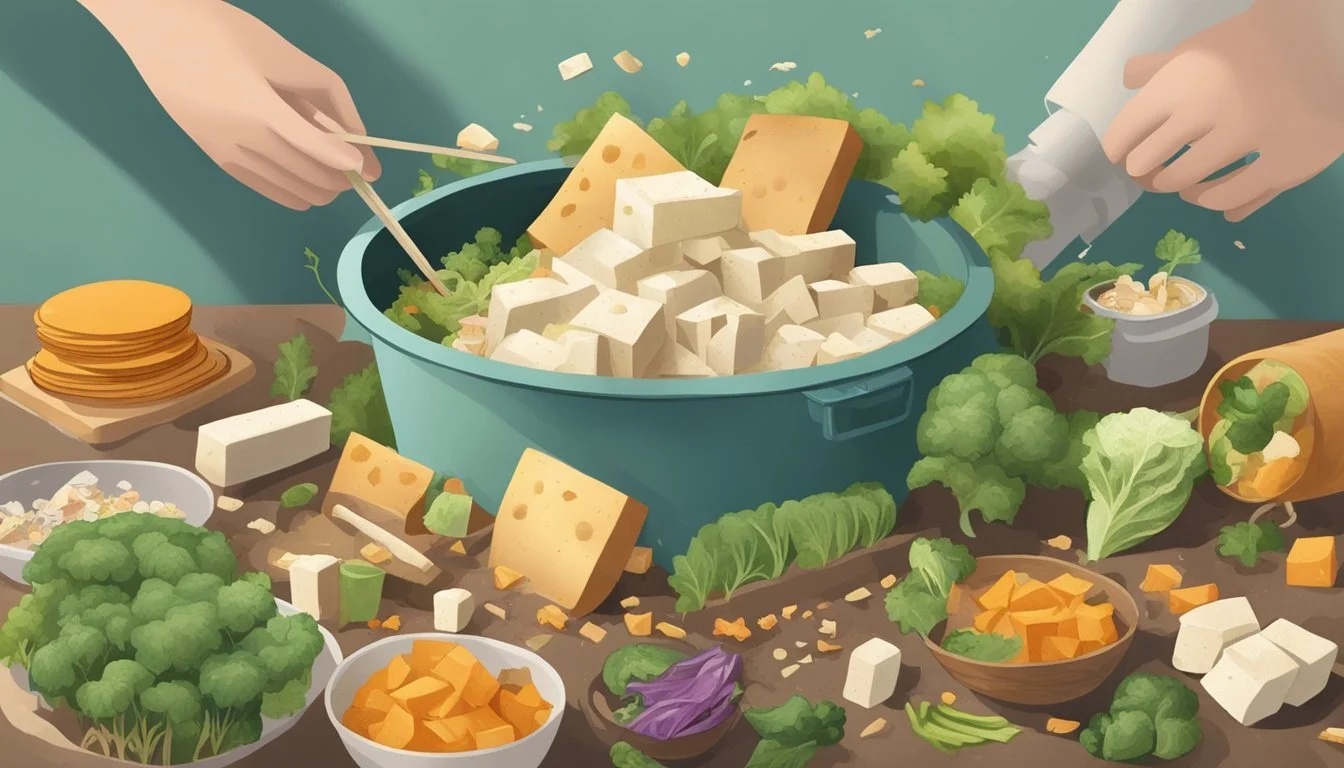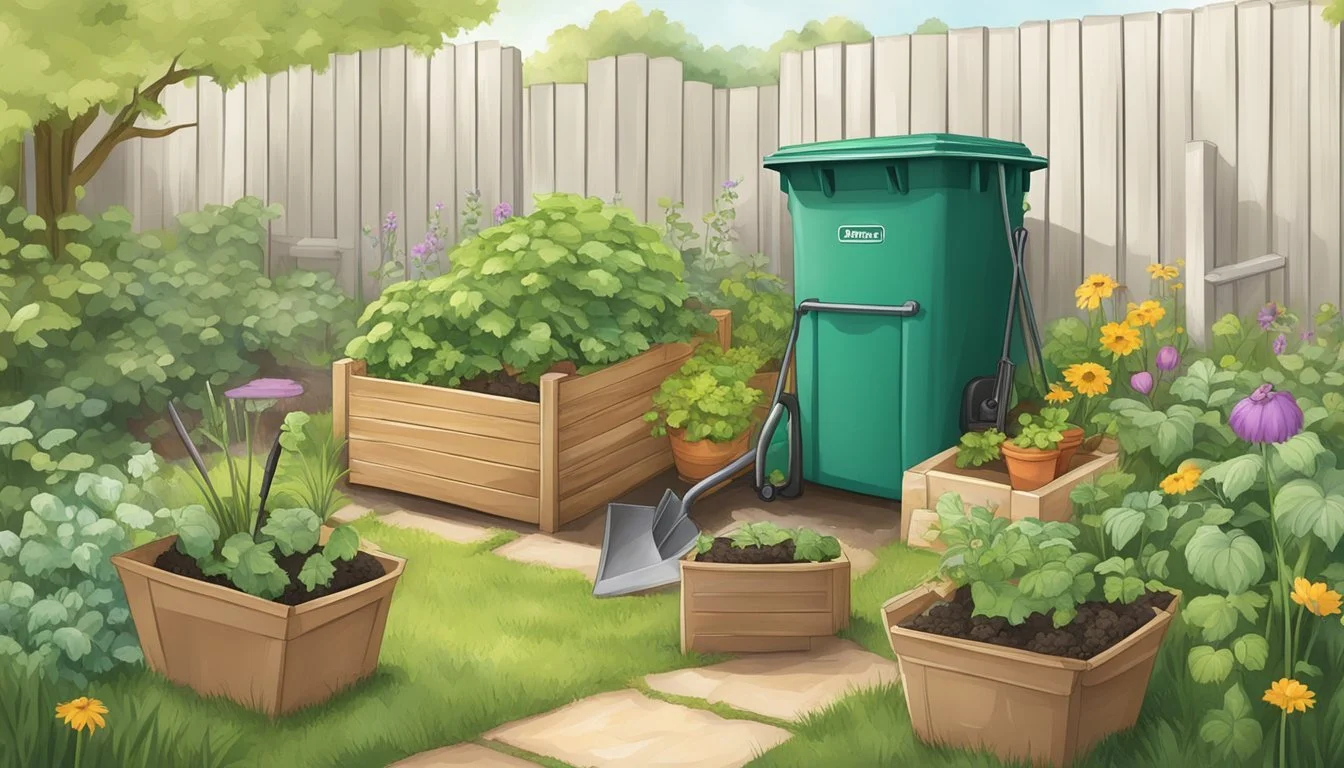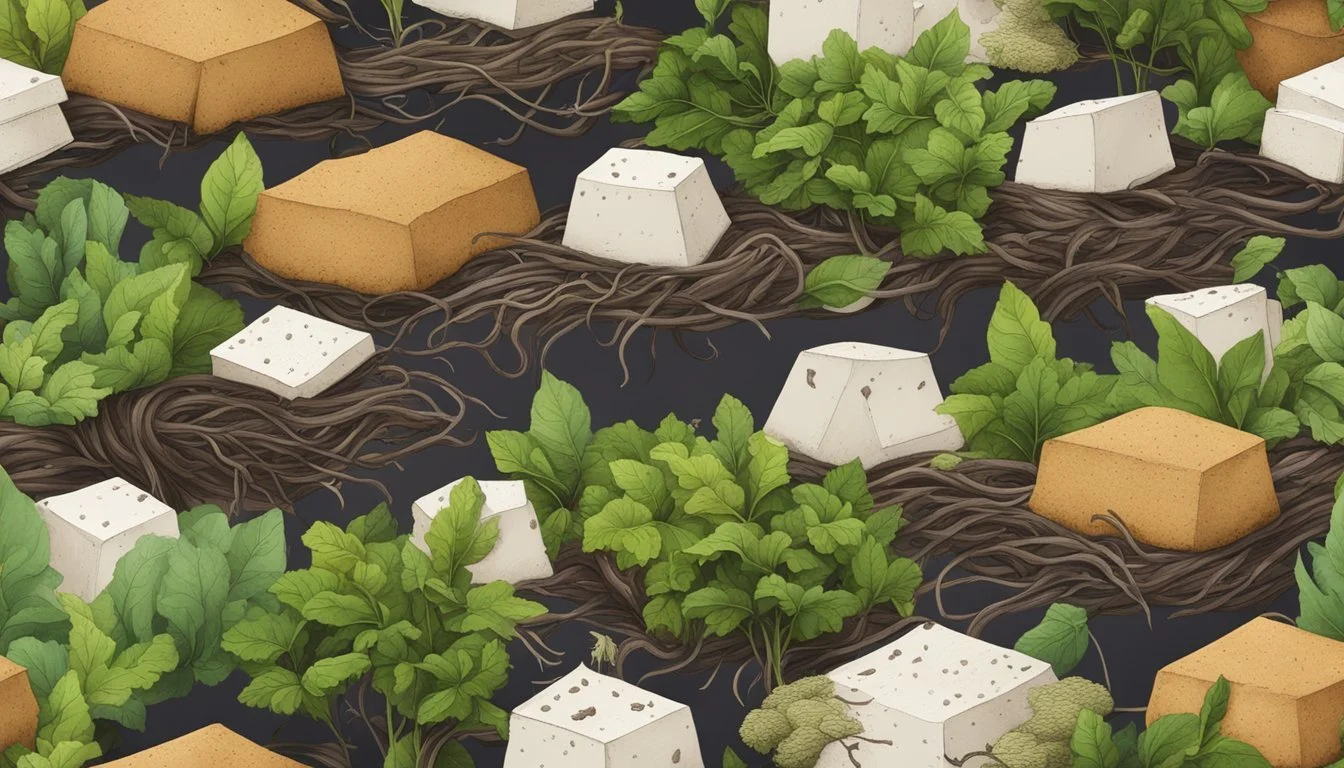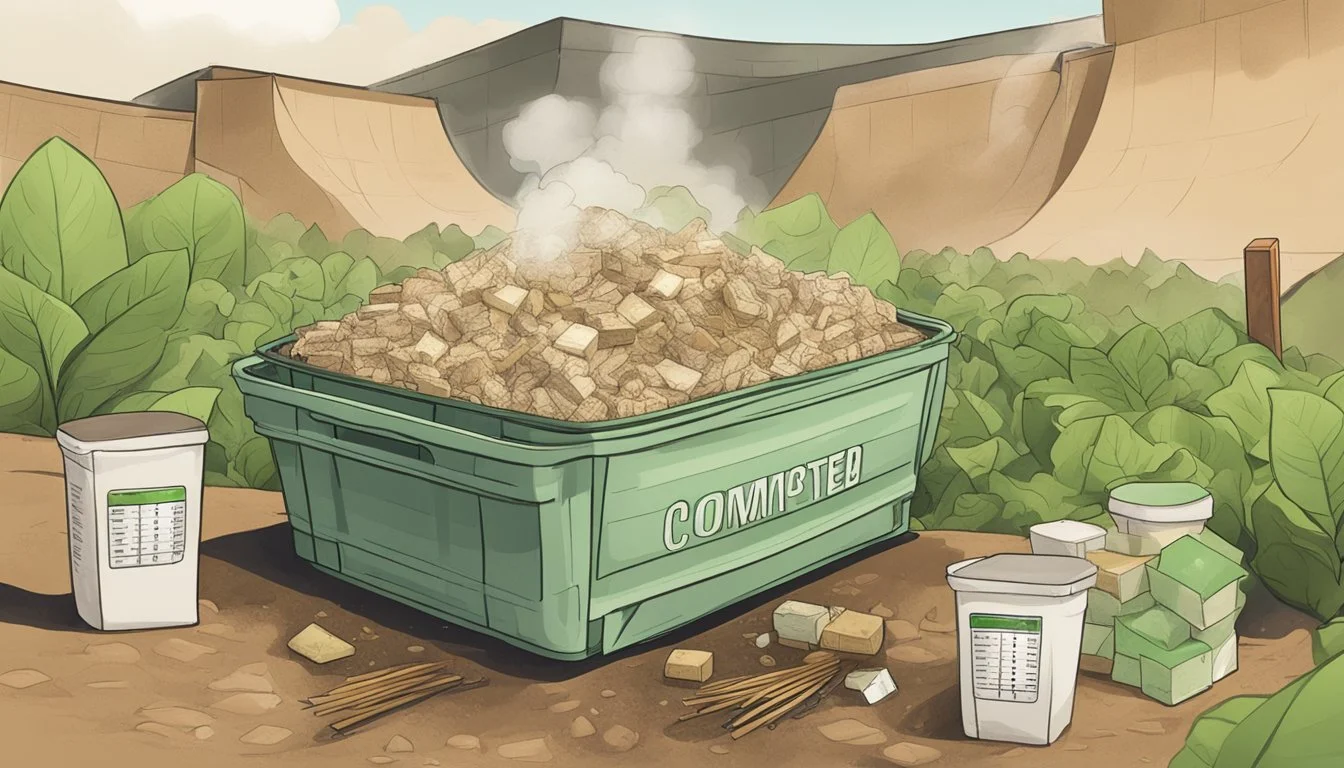Can You Compost Tofu?
Understanding Biodegradability of Plant-Based Foods
Composting is a natural process that turns organic waste into a nutrient-rich soil amendment. Tofu, a soy-based product, often raises questions regarding its compostability due to its protein content. It is important to recognize that tofu can indeed be composted effectively. As an organic material, tofu breaks down in a compost pile, contributing to the nitrogen content, which is essential for successful composting.
In the composting world, materials are generally categorized as 'green' or 'brown'; tofu falls into the 'green' category, meaning it is a source of nitrogen. Nitrogen is a critical component that works in tandem with carbon-rich 'brown' materials, such as dried leaves and cardboard, to create a balanced compost mixture. Composters should be mindful of the amount of tofu added to their compost piles to maintain this balance and avoid the potential for an overabundance of nitrogen which could destabilize the pile.
Understanding Composting
Composting is a method of recycling organic waste into nutrient-rich soil amendments through a natural decomposition process, governed by the balance of nitrogen, carbon, moisture, and air.
Basics of Composting
Composting requires a mix of 'greens' and 'browns'—materials rich in nitrogen and carbon, respectively. Greens include kitchen scraps like vegetable peelings, fruit waste, and in this context, tofu. Browns consist of dry leaves, straw, wood chips, and cardboard. An effective compost pile should have a carbon to nitrogen (C) ratio of about 25-30:1. This balance speeds up the decomposition while minimizing odor and deterring pests.
Greens (Nitrogen-rich Materials):
Kitchen scraps (vegetable peels, fruit waste, coffee grounds)
Tofu (organic, protein-rich matter)
Browns (Carbon-rich Materials):
Dry leaves
Wood chips
Cardboard
Role of Microorganisms
Microorganisms such as bacteria and fungi are the workhorses of the composting process. They break down organic matter into simpler compounds. The presence of nitrogen is crucial as it serves as a protein source for these microorganisms, energizing their activity. For optimal decomposition, the pile should maintain adequate levels of moisture and air, creating a suitable environment for microorganisms to thrive.
Compost Pile Composition
In any compost pile, the composition is key to success. The pile should maintain:
Organic Matter: Incorporating a variety of materials will lead to a more nutrient-rich compost.
Moisture: It should be akin to a wrung-out sponge—damp but not dripping.
Air: Regularly turning the compost ensures oxygen circulates throughout, aiding microorganism respiration.
A well-maintained compost heap will transform organic waste into compost over time, which is teeming with beneficial microorganisms and can be used to enrich garden soil, contributing to the growth of healthy plants.
Tofu as Compost Material
Tofu, a product made from soybeans, is a protein-rich food that is well-suited for composting. It serves as a 'green' component in the compost pile, providing essential nitrogen.
Benefits of Tofu in Compost
Nitrogen-Rich: Tofu is an excellent source of nitrogen, a critical nutrient in composting. It helps to balance the carbon-rich 'browns', such as leaves and twigs, creating an ideal environment for decomposition.
Accelerates Composting Process: The nitrogen in tofu helps to speed up the composting process by feeding the microorganisms that break down organic matter.
Reduces Food Waste: Adding tofu to a compost system repurposes what would be food waste, diverting it from landfills.
Potential Concerns
Balancing Act: While tofu is compostable, it's important to maintain the right balance between nitrogen and carbon in the compost pile. Too much nitrogen can lead to a smelly compost pile.
Protein Attracts Pests: Being rich in protein, tofu could attract pests if not properly mixed or buried within the compost.
Decomposition Time: In a balanced compost pile, tofu generally decomposes within 1-2 weeks, but this can vary based on the overall composting conditions.
Preparing Tofu for Composting
Proper preparation of tofu before adding it to a compost pile ensures efficient decomposition and contributes to a balanced composting process.
Size and Condition
Before composting tofu, one should cut it into small pieces. This increases the surface area, enhancing its breakdown by microbes. Ideally, tofu should be in half-inch cubes, which decompose more quickly than larger chunks. The condition of the tofu does not hinder compostability; both fresh and spoiled tofu can be used. However, spoiled tofu should be buried deeper in the compost to avoid attracting pests.
Balancing the Compost Pile
When adding tofu to a compost bin, it's crucial to maintain the right balance between greens, like tofu, and browns, which are carbon-rich materials. Tofu contributes nitrogen, an essential element that supports the composting process. A general guideline is to follow a ratio of 1 part greens to 2-3 parts browns. Materials such as dried leaves, straw, or shredded paper can serve as browns.
Mixing: It's important to thoroughly mix tofu into the compost pile instead of leaving it on top. Proper mixing prevents odors and accelerates decomposition.
Texture: The texture of tofu allows it to integrate well within the pile, enhancing the overall mixture.
By following these practices, tofu from soybeans and other food scraps convert effectively into nutrient-rich compost for gardening use.
Composting Process and Maintenance
Successful composting involves managing the decomposition process effectively to transform organic material into nutrient-rich soil. Key considerations include the stages of composting and keeping the compost healthy through proper maintenance.
Stages of Composting
Composting is a process that occurs in several stages, each critical to converting organic material like tofu into compost that can benefit plant growth. Initially, microorganisms start to break down the most accessible nutrients, raising the temperature of the compost pile. This is the active stage, where temperature can reach up to 160°F. In the subsequent curing stage, the pile cools, and the composting rate slows as the materials break down further over several months.
Active Stage:
Temperature rises.
Microorganisms break down organic materials quickly.
Curing Stage:
Temperature cools down.
The material decomposes at a slower pace.
Maintaining a Healthy Compost
To maintain a healthy compost pile, certain factors must be managed:
Moisture: Compost should be moist but not waterlogged. Squeeze a handful – it should feel like a wrung-out sponge.
Air: Aerating by turning the pile introduces oxygen necessary for microorganism activity and prevents odors.
Mixing: Regularly mixing the pile helps distribute air, moisture, and microorganisms evenly, speeding up decomposition.
Nutrients: A balance between 'greens' (nitrogen-rich materials like tofu) and 'browns' (carbon-rich materials like leaves) is essential.
Maintaining the right balance and managing these conditions ensures the compost pile breaks down materials effectively, enriching the final compost with nutrients that support soil structure and plant growth.
Additional Compostable Materials
Composting is not only about managing food waste like tofu; it encompasses a wide range of other organic materials that can be effectively recycled into nutrient-rich soil. Here's how one can incorporate various kitchen scraps, yard waste, and paper products into a composting routine.
Kitchen Scraps and Yard Waste
In the compost bin, kitchen and garden waste are essential contributors to creating a balanced compost mix. Kitchen scraps include:
Vegetables: All types of vegetable scraps can be composted, from carrot tops to potato peels.
Fruit scraps: Similar to vegetables, fruit remnants are an excellent addition.
Coffee grounds and tea bags: These are rich in nitrogen, making them beneficial for the compost heap.
Eggshells: Crushed eggshells contribute calcium, but they should be rinsed and broken down before adding.
Yard or garden waste plays a pivotal role in adding carbon to the mix and includes:
Leaves: Dry leaves are an excellent source of carbon, balancing the nitrogen-rich kitchen scraps.
Grass clippings: Fresh grass clippings can be added; however, they should be mixed well to prevent matting.
Garden trimmings: Plant and flower cuttings are compostable, but one should avoid adding diseased plants.
Worms naturally find their way into compost bins and help break down the material more efficiently. However, not all kitchen and garden waste are suitable for a worm composting system as certain materials can harm the worms.
Paper and Cardboard Products
Paper and cardboard can be a valuable addition to a compost pile, particularly as a source of carbon. When composting these materials, it's important to consider a few key points:
Shredded paper: Non-glossy paper should be shredded to speed up the decomposition process.
Cardboard: It should be cut into small pieces and ideally soaked to help it break down faster.
Coffee filters: If made of paper and unbleached, they are compostable along with the coffee grounds.
It is important to avoid composting glossy paper and paper with a lot of colored ink, as these can introduce toxins into the compost. When in doubt, it's best to leave it out or recycle through other means.
Avoiding Composting Pitfalls
Proper composting can enhance soil quality and environmental health, but certain mistakes can undermine these benefits. This section provides insights on how to avoid common composting errors related to inappropriate items and the management of pests and odors.
Items to Exclude
Certain materials should not be added to compost piles because they can attract pests, cause odors, and slow down the composting process. These include:
Meat: Attracts pests and can cause odor issues.
Dairy: Similar to meat, it can attract unwanted pests and produce foul odors.
Oils and Fats: These ingredients can cause imbalances in the compost pile, attract rodents, and are harder to break down.
Greasy Foods: Like fats and oils, greasy foods can attract rodents and take a long time to compost.
Managing Pests and Odor
To maintain a healthy composting environment:
Balance: Ensure a good balance between "green" (nitrogen-rich) and "brown" (carbon-rich) materials to minimize odors.
Layering: Cover food scraps with brown materials like leaves or shredded paper to deter pests.
Turning: Regularly turn the compost pile to aerate and discourage rodents from nesting.
Burying: Bury food wastes in the center of the pile to make it less accessible to pests.
By carefully excluding certain items and adopting informed practices, composters can prevent common problems, thereby creating a more effective and less problematic composting process.
Using Compost in Gardening
The inclusion of compost in gardening practices is essential for soil health and plant growth, offering an eco-friendly approach to sustainable living.
Benefits to Soil Health
Compost contributes significantly to soil health by introducing beneficial microorganisms that enhance soil structure and fertility. Utilizing compost in a garden:
Improves soil aeration: The breakdown of organic matter in compost creates a porous soil structure, allowing roots to receive ample oxygen.
Enhances water retention: Compost allows soil to hold moisture more effectively, which is crucial for plant hydration.
Boosts nutrient content: Compost is inherently nutrient-rich, providing essential nutrients for plants that are released slowly over time.
Fosters a living soil: Introducing compost increases the diversity of life in the soil, including bacteria, fungi, worms, and other organisms that are integral to a healthy ecosystem.
Application in the Garden
Proper application of compost in the garden ensures that it contributes to soil health and sustains plant growth:
Incorporate compost at planting: When planting new plants, mix compost into the planting holes and the surrounding soil to give plants a nutrient-rich start.
Add as a top dressing: Spread compost around existing plants to slowly integrate nutrients into the soil without disturbing plant roots.
Use as mulch: Apply a layer of compost to the soil surface to maintain moisture levels, regulate soil temperature, and reduce weed growth.
Maintain balanced application: Excessive compost can overwhelm the plants with nutrients, so it's vital to apply the right amount based on the needs of the specific garden plants and soil conditions.
Incorporating compost into gardening practices is not only beneficial for plant vitality but is a cornerstone of eco-friendly and sustainable living.
Environmental Impact of Composting
Composting offers a vital strategy for reducing the environmental footprint by diverting organic waste from landfills and supporting sustainable living practices.
Reducing Food Waste
When food waste ends up in landfills, it decomposes anaerobically (without oxygen), producing methane, a potent greenhouse gas. Composting, by contrast, is an aerobic process that significantly reduces methane emissions from organic matter. By turning tofu and other food scraps into compost, individuals and communities alike help decrease the volume of waste in landfills, contributing to a more eco-friendly waste management system.
Composting and Sustainability
Composting enhances soil quality by adding vital nutrients such as carbon and nitrogen back into the earth. It promotes the creation of humus, a rich nutrient-filled material that improves soil structure, water retention, and plant growth. This is essential for sustainable living, as it lessens the need for chemical fertilizers, thus making it a form of sustainable resource management. Additionally, the use of compost can benefit community gardens, providing a localized and sustainable source of organic matter for plant cultivation, and fostering a sense of environmental stewardship within the community.
Advanced Composting Techniques
Incorporating tofu into a composting regimen requires a nuanced approach to encourage rapid breakdown and nutrient assimilation. Advanced composting techniques such as vermicomposting and Bokashi composting offer distinct processes that harness the activities of worms and microorganisms to facilitate organic waste decomposition.
Vermicomposting
Vermicomposting involves the decomposition of organic waste using various species of worms, particularly red wigglers. These worms are efficient at breaking down food scraps and can process tofu, transforming it into nutrient-rich castings. While vermicomposting, one must ensure a balanced mix of "greens" (such as tofu) and "browns" (like dried leaves or paper) to maintain a habitable environment for the worms and avoid odors.
Optimal Conditions:
Moisture: Keep bedding moist, but not soggy
Temperature: Maintain between 55°F and 77°F (13°C and 25°C)
pH: Aim for a neutral pH
Bokashi Composting
Bokashi composting is an anaerobic process that utilizes inoculated bran to ferment organic materials before they are traditionally composted. When incorporating tofu, it's essential to cut it into smaller pieces to speed up fermentation. Beneficial microorganisms in the Bokashi bran facilitate the breakdown of the tofu, preparing it for final composting in a traditional compost heap or garden soil.
Step-by-Step Process:
Cut tofu into small pieces.
Layer tofu with Bokashi bran in the composting bin.
Seal the bin and let sit for approximately two weeks before burying the contents into the soil.
Regularly applying these advanced techniques supports sustainable living practices by effectively recycling tofu as a valuable compost ingredient, enriching soil fertility and structure while reducing waste.
Community and Urban Composting
In metropolitan areas, community and urban composting initiatives are valuable assets for sustainability efforts. These programs provide residents—including those living in apartments without individual garden space—ways to contribute to composting efforts.
Community Garden Composting
Community gardens are integral to urban composting, serving as localized hubs where residents can bring organic waste, such as tofu, to be transformed into nutrient-rich compost. These gardens usually feature compost bins or designated composting areas, which are managed to ensure proper breakdown of materials. They not only help in reducing landfill waste but also educate the public on sustainable practices. Residents benefit from this cycle by gaining access to compost for their personal gardening projects within the garden itself.
Location: Community gardens situated within urban areas or apartment complexes.
Contribution: Residents contribute organic waste for communal composting.
Benefits: Reduction in waste, soil enrichment, and community engagement.
Urban Composting Solutions
Urban composting solutions focus on adapting composting practices to the constraints of urban living. This often involves innovative methods like composting in tiers and using specially designed bins to handle waste efficiently and hygienically, addressing common concerns such as odors and pests. These strategies enable apartments and residential complexes to manage waste sustainably despite limited space.
Innovation: Use of compact, tiered composters to optimize space.
Design: Bins designed to be odor-free and pest-resistant.
Implementation: Solutions adaptable to various urban settings, including parks and vacant lots.
Composting Regulations and Guidance
Municipalities often have specific regulations governing composting practices to ensure public health and safety. Individuals seeking to compost tofu and other food scraps must check with local authorities, as guidelines can vary.
For instance, some legal frameworks may classify tofu as a green material due to its nitrogen content and thus permit its inclusion in compost bins. Conversely, other regions might have restrictions on composting tofu, especially in urban settings, as it could attract pests or produce unwanted odors.
Best practices for composting, including tofu, involve:
Maintaining a balanced mix of greens (such as food scraps) and browns (like yard waste) to optimize the composting process.
Ensuring the compost pile has adequate aeration and moisture.
Regulating the temperature to accelerate decomposition while preventing the proliferation of harmful bacteria.
Guidelines for compost production and utilization, particularly for organic crop production, may be stricter. For example, the National Organic Program provides clarity on composting standards, emphasizing that all processes should support a sustainable ecosystem and considerate use of resources.
Local authorities or environmental agencies may offer guidance on composting methods, such as:
Method Description Backyard Bin Traditional composting in an outdoor bin Vermicomposting Utilizing worms to break down waste
Following these directives ensures that composting remains an eco-friendly method of reusing waste, bolstering soil health, and reducing landfill reliance. Individuals are encouraged to stay informed about the latest updates in composting regulations and practices for a positive environmental impact.











